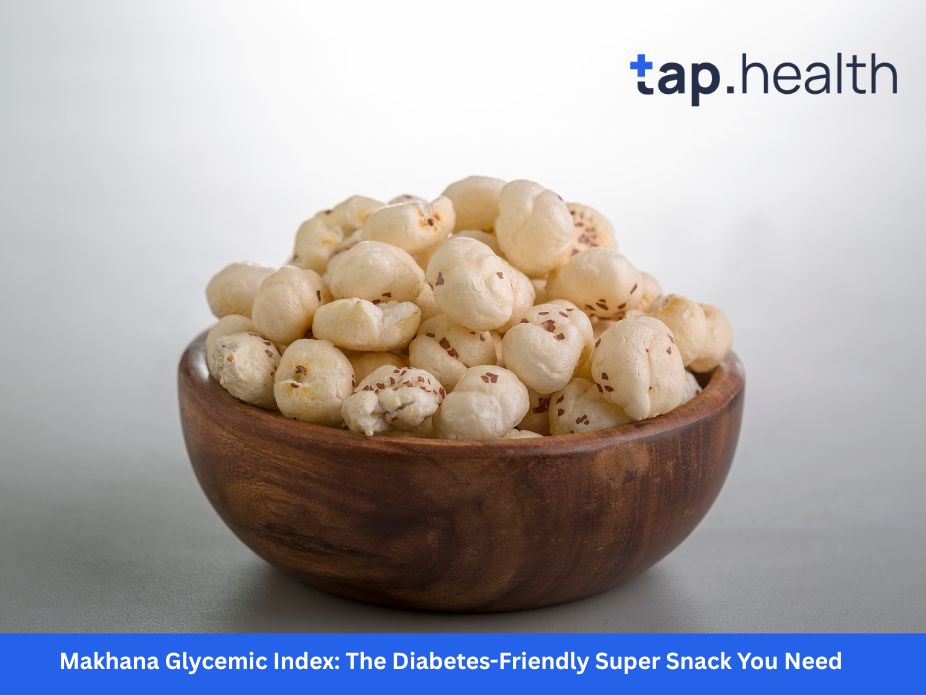Let’s play a quick game. Think about your favorite crunchy snacks. What comes to mind? Potato chips? Nachos? Maybe something that goes “pop”?
Now, ask yourself: after munching on those snacks, do you feel energized and satisfied? Or do you feel sluggish, thirsty, and strangely hungry again just a little while later?
Most popular snacks give us that quick crunch but leave us on a energy rollercoaster. This is because they are often high on something called the Glycemic Index (GI).
But what if there was a snack that was just as crunchy, but actually good for you? A snack that could keep your energy stable, help manage blood sugar, and even support your weight goals?
Welcome to the world of Makhana.
Also known as fox nuts or lotus seeds, these little white puffs are a nutritional powerhouse. And the secret to their superpower lies in one key feature: their glycemic index.
In this article, we’re going to explore everything about the glycemic index of Makhana. We’ll break down the science into simple, easy-to-understand language, so you can feel confident making smarter snack choices. Let’s dive in and uncover why Makhana is the snack you’ve been searching for.
What is the Glycemic Index (GI)? The “Speed Limit” for Your Food
Before we talk about Makhana specifically, let’s get one thing clear: what exactly is the Glycemic Index?
Think of the carbohydrates in your food as cars on a highway leading to your bloodstream. The Glycemic Index is like the speed limit for those cars.
It’s a scale from 0 to 100 that measures how quickly a carbohydrate-rich food makes your blood sugar (glucose) levels rise.
Here’s how the scale works:
- Low GI (55 or less): The “Slow Lanes.” These foods break down slowly, releasing sugar into your blood at a gentle, steady pace. This keeps you feeling full and energized for hours. Examples: most fruits, lentils, beans, and whole oats.
- Medium GI (56 to 69): The “Moderate Speed Lanes.” These provide a medium-speed energy release.
- High GI (70 and above): The “Fast Lanes.” These foods are like race cars. They break down extremely quickly, causing a rapid spike in your blood sugar. This spike is often followed by a sharp crash, leaving you feeling tired, irritable, and hungry again. Examples: white bread, sugary drinks, and potato chips.
Eating a lot of high-GI foods is like being on a energy rollercoaster all day. For people with diabetes or those trying to manage their weight, this rollercoaster is the last thing they need.
So, What is the Glycemic Index of Makhana?
Now for the moment you’ve been waiting for. Let’s get to the number.
Makhana has a very low Glycemic Index. It scores around 35 on the GI scale.
Let that sink in for a moment. With a GI of approximately 35, Makhana sits firmly in the excellent, slow-digesting low GI category.
This means that when you snack on Makhana, your body gets a slow and steady supply of energy. There’s no sugar rush, and critically, no sugar crash. It’s the complete opposite of what happens when you eat a bag of chips or cookies.
Makhana vs. The Competition: A GI Snack Showdown
To truly appreciate how good Makhana is, let’s see how it stacks up against other common snacks.
- Makhana (GI ~35) vs. Potato Chips (GI ~75+): This is a no-brainer. Chips are in the high GI zone, while Makhana is a low-GI champion.
- Makhana (GI ~35) vs. White Bread (GI ~75): White bread acts almost like sugar in your body, while Makhana provides sustained energy.
- Makhana (GI ~35) vs. Puffed Rice (GI ~80+): Puffed rice, a common snack base, causes a massive blood sugar spike. Makhana does the opposite.
- Makhana (GI ~35) vs. An Apple (GI ~36): They are in the same league! This really puts into perspective just how blood-sugar-friendly Makhana truly is.
As you can see, choosing Makhana over these common snacks is a game-changing decision for your metabolic health.
Why is Makhana’s Glycemic Index So Low?
You might be wondering, “What makes these little puffs so special?” The answer lies in their brilliant nutritional composition. It’s not one thing, but a powerful combination of factors working together.
The Power of Complex Carbs and Fiber
Makhana is rich in complex carbohydrates and a good source of dietary fiber.
- Complex Carbs: Unlike simple carbs (found in sugar and white flour), complex carbs have a more complicated structure. Your body has to work hard to break them down. This slow digestion process is the main reason for the slow and steady release of glucose.
- Dietary Fiber: Think of fiber as a sponge in your digestive system. It slows down the entire digestion process, including how quickly sugars are absorbed into your bloodstream. This fiber acts as a natural brake, preventing blood sugar spikes.
The Protein Punch
Makhana is surprisingly high in protein for a plant-based snack. Protein is another nutrient that takes longer to digest. When you combine protein with carbs (like in Makhana), it further slows down the conversion of carbs into sugar, leading to an even more stable blood sugar response.
It’s Naturally Low in Unhealthy Fats
In their raw, air-popped form, Makhana is very low in unhealthy saturated fats. While fats also slow down digestion, the low-GI benefit of Makhana comes primarily from its high fiber and protein content paired with complex carbs, making it a very clean and effective snack.
Is Makhana Good for Diabetes?
This is the most important question for many people, and the answer is a resounding yes.
Makhana is an excellent snack choice for people with diabetes and prediabetes.
Here’s why:
- Prevents Spikes: Its low GI means it won’t cause the dangerous blood sugar spikes that high-GI foods do.
- Promotes Satiety: The combination of fiber and protein keeps you feeling full. This helps prevent overeating and unhealthy snacking on sugary foods, which is crucial for diabetes management.
- Nutrient-Dense: It provides essential minerals like magnesium and potassium, which are important for overall metabolic health.
Of course, portion control and preparation method still matter (we’ll get to that!), but as a food, Makhana is a diabetic-friendly superstar.
Beyond Blood Sugar: The Amazing Health Benefits of Makhana
While the low glycemic index of Makhana is its headline feature, this humble snack offers a treasure chest of other health benefits.
A Heart-Healthy Hero
Makhana is naturally low in sodium and high in magnesium and potassium. This combination is excellent for maintaining healthy blood pressure levels. Furthermore, they contain compounds that have antioxidant properties, which help reduce inflammation and support overall heart health.
Your Ally in Weight Management
Trying to lose or maintain weight? Makhana is your best friend.
- Low in Calories: A one-ounce (28-gram) serving has only about 100-110 calories, making it a low-calorie snack.
- High in Satiety: You feel full and satisfied after eating them, which reduces the temptation to reach for more calorie-dense, unhealthy options.
Gluten-Free and Easy to Digest
For people with celiac disease or gluten sensitivity, Makhana is a safe and delicious crunchy snack. It’s also known in Ayurveda for its easy-to-digest properties, making it gentle on the stomach.
Rich in Antioxidants
Makhana contains important antioxidants like gallic acid and chlorogenic acid. These substances help fight oxidative stress in your body, which can damage cells. This contributes to anti-aging, better skin health, and a lower risk of chronic diseases.
How to Enjoy Makhana: Tasty and Healthy Ideas
The best part about Makhana is its versatility. It’s like a blank canvas waiting for your favorite flavors. Here’s how to make it a part of your diet.
The Perfect Base: How to “Roast” Makhana
To unlock its crunch and flavor, you need to cook it properly. Frying it in lots of oil defeats the purpose. Instead, dry roast it:
- Heat a non-stick pan on a medium flame.
- Add the raw Makhana and dry roast for 4-5 minutes, stirring continuously, until they become crisp.
- Then add a teaspoon of ghee or oil. This sequence ensures they stay crispy.
Flavor Combinations to Try
Once roasted, toss them with your favorite seasonings:
- Simple & Savory: A pinch of salt, black pepper, and a sprinkle of turmeric.
- Indian Spiced: Chat masala, roasted cumin powder, and a dash of lime juice.
- Cheesy & Herby: Nutritional yeast or a sprinkle of dried oregano and thyme.
- Sweet Cinnamon: A light drizzle of honey (use sparingly if diabetic) and a dusting of cinnamon.
Integrating Makhana into Meals
- As a Snack: Enjoy a small bowl on its own.
- In Curries: Add them to vegetable curries or gravies. They absorb the flavor beautifully and add a great texture.
- In Soups: Use them as a healthy crouton alternative to top your soups.
- As a Dessert: Make a kheer (pudding) by cooking Makhana in milk with natural sweeteners like dates.
A Final Word: The Smart Snack You Can Trust
In a world full of processed, high-sugar snacks that hijack your blood sugar and energy levels, Makhana is a refreshing and powerful alternative.
Its low glycemic index makes it a safe, satisfying, and smart choice for everyone—especially those managing diabetes, PCOS, or weight.
So, the next time you feel a snack attack coming on, skip the chips and reach for the Makhana. Your body will thank you for the steady energy, and your taste buds will love the delicious crunch.
Frequently Asked Questions (FAQs) on Makhana Glycemic Index
Q1: Can diabetics eat Makhana every day?
A: Yes, in moderate portions, diabetics can enjoy Makhana daily. Its low GI helps in maintaining stable blood sugar levels. A typical serving size is about a fistful (around 20-30 grams). It’s always best to monitor your blood sugar levels to see how your body personally responds.
Q2: Is Makhana good for weight loss?
A: Absolutely. Makhana is an ideal weight-loss snack. It is low in calories, high in fiber and protein, and very filling. This combination helps curb hunger and prevents overeating, making it easier to maintain a calorie deficit.
Q3: What is the best way to eat Makhana for maximum health benefits?
A: The healthiest way is to dry-roast them first to achieve crispiness, and then add a very small amount of healthy fat like ghee or olive oil and season with herbs and spices. Avoid deep-frying or coating them in excessive sugar or salt.
Q4: How does Makhana compare to popcorn?
A: Air-popped popcorn is also a good whole-grain, high-fiber snack. However, Makhana generally has a slightly lower GI, is higher in protein, and is often considered more filling. Both are excellent choices compared to potato chips, but Makhana has a slight edge for blood sugar control.
Q5: Are there any side effects of eating too much Makhana?
A: Makhana is very safe for most people. However, due to its high fiber content, eating a very large amount in one sitting could cause temporary gas or bloating for some. As with any food, moderation is key.
Q6: Is Makhana a protein or a carb?
A: Makhana is primarily a carbohydrate, but it’s a complex carb with a good amount of plant-based protein and fiber. This unique mix is what gives it its low GI and high satiety value.
Q7: Can I eat Makhana at night?
A: Yes, Makhana is a great evening snack. Its low GI means it won’t cause a blood sugar spike that can disrupt sleep, and its light, digestible nature makes it a better option than heavy, sugary snacks before bed. A small bowl of roasted, lightly salted Makhana is a perfect nighttime treat.



